“¡Pedro, gracias por ser el mejor director de tesis con que podría haber soñado! Y muchísimas gracias por la amistad que me has brindado! Un agradecimiento muy especial a mi compañera Julia, con quien he empezado mi labor en la biología molecular de Arabidopsis. Gracias por estar siempre presente y por el apoyo constante, por compartir los muchos buenos momentos (y también uno que otro menos bueno), y gracias por esa sonrisa que hace que sembrar unas miles de semillas de Arabidopsis sea una tarea agradable.”
Americo Rodrigues (deceased)
The above quote is from the acknowledgements in the PhD thesis by Américo Rodrigues, dedicated to his advisor Pedro Rodriguez, professor of plant biochemistry at the Instituto De Biología Molecular Y Celular De Plantas (IBMCP) in Valencia, Spain, and his former lab mate Julia Santiago, now professor at the University of Lausanne, Switzerland. Rodrigues tragically died in 2020, which incidentally makes it very convenient to blame him for research fraud in your papers and even your own PhD thesis, as both Santiago and Rodriguez did on PubPeer. At the same time, the young professor blames the older professor for instructing his students to plagiarise each other, a practice the latter actually openly defends.
Curtains up for the next act of this passionate, hilariously bizarre and credibility-straining lab travesty from Spain, which starts looking like una pelicula de Pedro Almodovar.

It is the follow-up to my previous article, about the data manipulations in Rodriguez’ papers, one of which (Santiago, Rodrigues et al 2009) was already announced to be retracted, because it contains falsified figures.
Santiago supports the retraction, yet she declared on PubPeer that she has “not done any of the flagged image manipulations“, because she either “did not contribute to the experiments” flagged as fabricated, or at least “was not involved in the selection of the figure panels or in the assembly of the final figure for publication“. In her own first-author paper, mind you. I am not sure if she wrote the same when applying for her endowed chair by the Sandoz Family Foundation, or her €1.5 million ERC Starting Grant.
Problem is, those same figures appeared in Santiago’s own PhD thesis. She now blames her deceased colleague Americo Rodrigues for the forgeries and her ex-boss Pedro Rodriguez for making her include those fake figures in her thesis. The University of Lausanne professor is actually the victim here, and the dead man from Portugal is the main culprit.
It gets weirder. It is not just Santiago’s PhD thesis at the Biotechnology Department at the Polytechnic University Valencia from 2011 which contains falsified figures which Santiago claims she had not made herself, also the 2013 PhD thesis of her colleague Regina Antoni Alandes recycles the same figures, including the falsified ones. Their Valencia professor was apparently the one who instructed his students to do recycle the data without attribution, which is basically plagiarism: he not only doesn’t deny it, he even endorses this practice. Rodriguez even explained to me that since the two students shared a paper, they can also share the figures in it without the need for an additional acknowledgment.
However, the PhD thesis of the deceased scapegoat Américo do Patrocínio Rodrigues, titled Abscisic acid signal transduction: Regulation by HAB1 and interaction with brassinosteroids mediated by BRX and supervised by Pedro Luis Rodríguez Egea, does not contain any of those figures. Although it does contain another one flagged for manipulations:
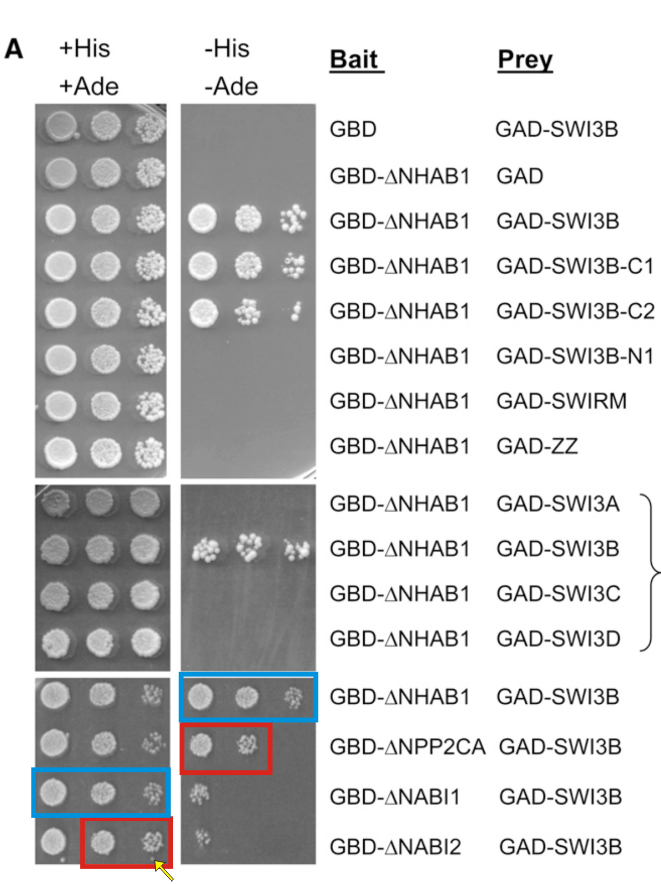
Let us first ahve a look at the PhD thesis from 2011 by Julia Santiago Cuéllar, supervised by Pedro L. Rodríguez Egea, titled:
Structural insights into ABA perception and signalling: structure of ABA receptor PYR1
Sure sure, we were told the falsified figures in Santiago’s peer reviewed papers were done by someone else, that dead Portuguese colleague. What about the falsified figures in her own thesis, otherwise not published in a journal? Who faked those?


This looks bad. Some plants were not just copy-pasted in Photoshop, they were also digitally retouched to look different. Obviously retracting a PhD thesis is not an option, because that would definitely, immediately and irreversibly terminate Santiago’s academic career. Think, Julia, think, how can we solve this?
So the young Lausanne professor posted this PubPeer comment:
“The work presented in chapter4 of my thesis from the Polytechnical University of Valencia contains an unpublished progress report on the preliminary genetic characterization of two Oriza sativa PP2CA phosphatases. This work was jointly performed with my lab colleague Americo Rodrigues at the beginning of my PhD (2007-2009). Americo completed this work during my extended research stay the EMBL Grenoble, France (2009-2011). Together with Americo I did the transgenic crosses and I generated Figs. 1, 2, 3, 4, 6BCD, 7AC shown in the thesis. Americo completed the phenotyping of the lines shown in Figs. 5, 6A and 7B and the analysis shown in Fig. 8. I have checked Figs. 5, 6A and 7B and indeed there are severe image manipulations of the seedlings shown in these figure panels. This joint work was included in my PhD thesis at the last minute per request by my PhD supervisor Dr. Pedro Rodriguez. I should have credited Americo in the figure legends of figures 5, 6A , 7B and 8 and I regret for not having spotted these manipulations myself.“
The comment was soon moderated by PubPeer, but here is a screenshot:

Americo alone was responsible for these “severe image manipulations“! And Julia only was forced to put this stealthy fraud into my thesis because of “the last minute per request by my PhD supervisor Dr. Pedro Rodriguez“. Julia is the real victim here, do you see it now?? Her only fault is “not having spotted these manipulations myself“, and he without the sin shall cast the first stone here.
Or wait, there is more, in Chapter 3, Figure 3D:
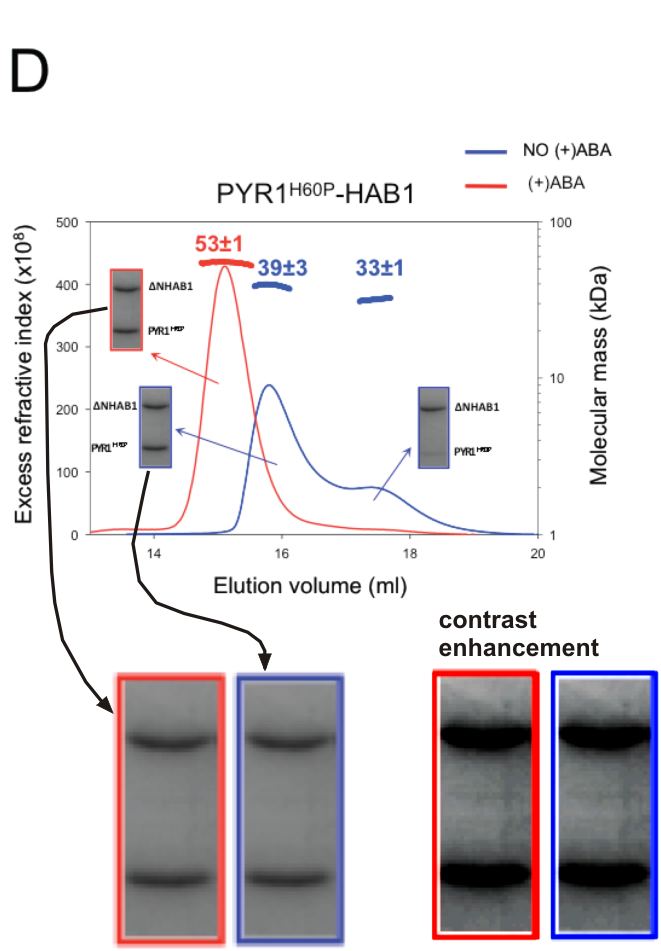
Also published as Fig 3D in Dupeaux, Santiago et al EMBO J 2011. Santiago explained on PubPeer that the gel image “has been accidentally introduced twice” and that she will issue a correction. Puh, another bomb elegantly defused. Time for a well-deserved gazpacho?
But then someone asked on PubPeer:
“Considering that you generated fig. 4 and fig. 6B of your thesis, I was wondering if you can explain why the ACT1 lanes are duplicated into fig. 6B (already reported by Parus Major) and also between fig. 4 and fig. 6B (see below).”
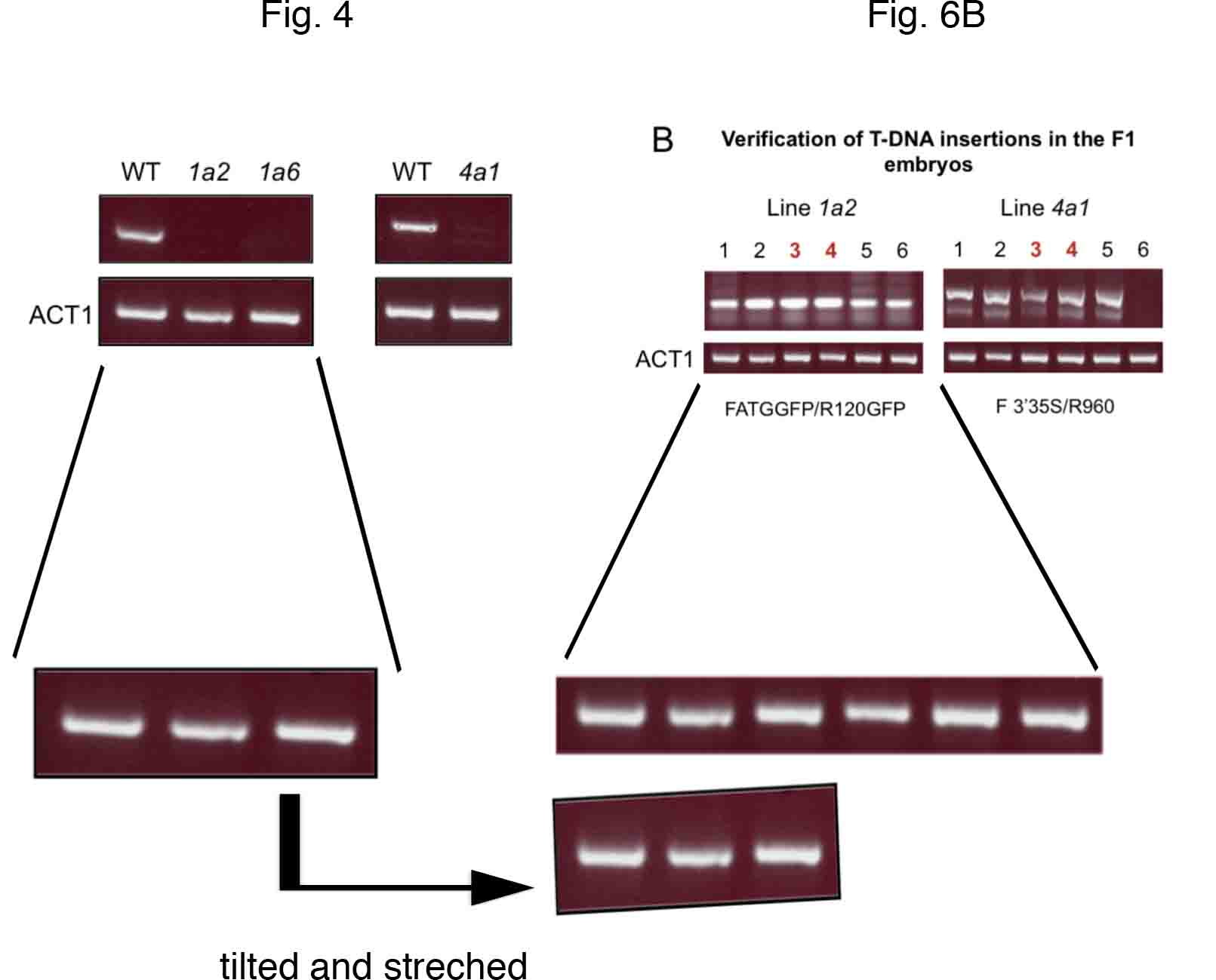
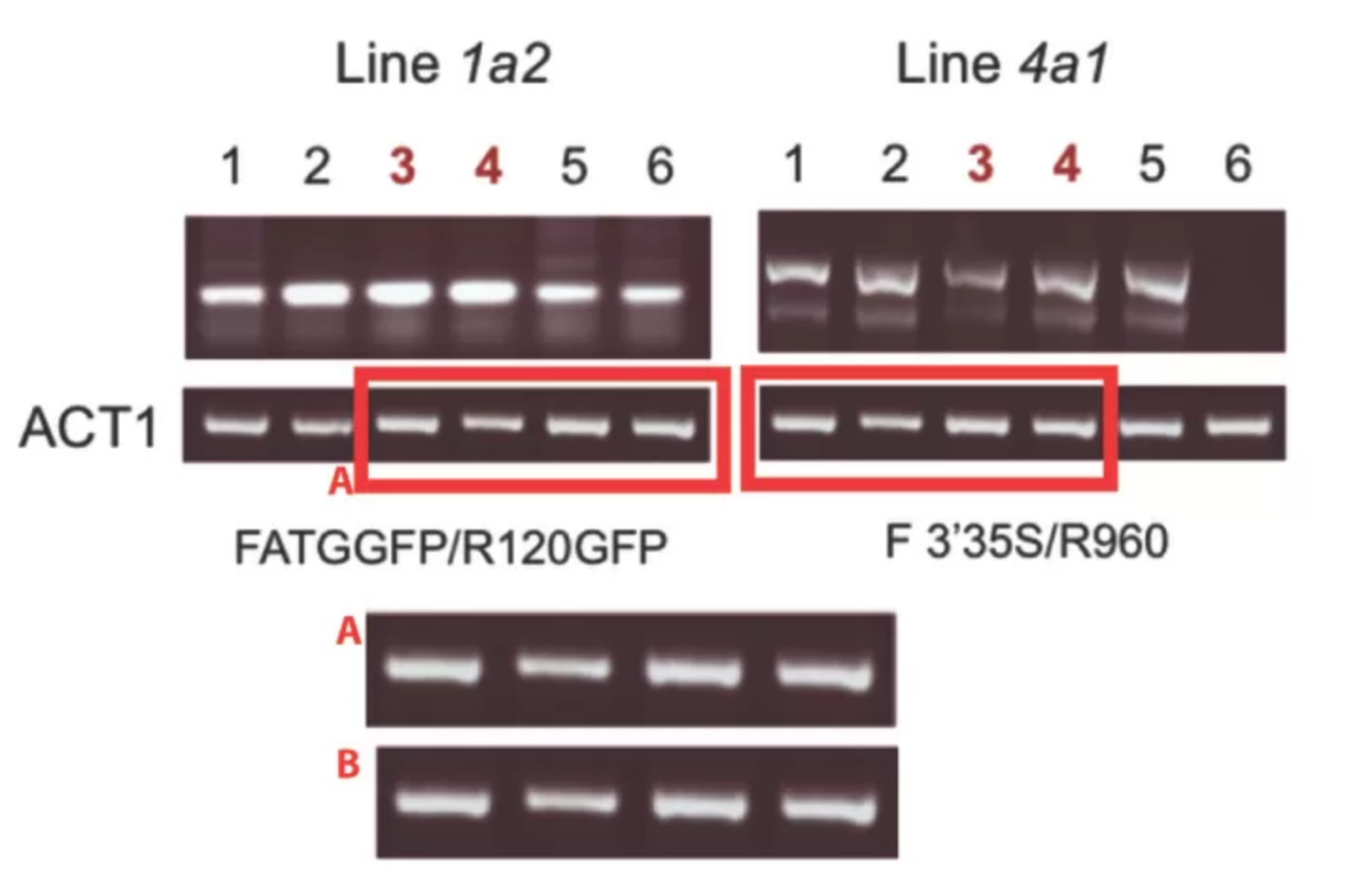
Santiago corrected, that first of all, “there is a labeling error in your figure in comment #16. You are comparing figures 4B (page 154) and figure 7B (page 159), not 6B (page 157).“
And because her previous comment where she openly blamed Americo Rodrigues was moderated by PubPeer, Santiago wrote now:
“Based on the commenting guidelines, I cannot comment on the potential reuse of figure 4B in figure 7B.“
Ha! Ha! Hahahaha! Dead men can’t talk, which means they can’t defend themselves or spill secrets. Gazpacho, anyone?

And anyway, look at what others have in their PhD theses. As it turned out, the data from Santiago’s thesis was recycled 2 years later in the 2013 PhD thesis by Regina Antoni Alandes, supervised by their mutual boss, Pedro L. Rodríguez Egea:
Molecular and genetic analyses of the PP2C-ABA receptor interaction in the abscisic acid signaling pathway

As it happens, Antoni is now head of the single cell unit at the Josep Carreras Leukemia Research Institute in Barcelona. Its director is a crook who published and defended massive fraud (including by his mentee Sonia Melo!) and was promoted exactly because of it: Manel Esteller.
The Valencia professor Rodriguez saw no problem with the data recycling by his PhD students, he wrote to me in an angry email:
“I will not contribute to your permanent slur on my group
You can see in page 107 Santiago’s thesis
Appendix Chapter 2
Data published in Plant Physiology (2011) 156, 106-116
These authors contributed equally to this work
Dupeux F*, Antoni R*, Betz K*, Santiago J*
You can see in page 41 Antoni’s thesis
Data published in Plant Physiology (2011) 156, 106-116
These authors contributed equally to this work
Dupeux F*, Antoni R*, Betz K*, Santiago J*
Obviously, there is acknowledgment on previous publication of these data. When several persons contributed to a complex figure (at it was the case because SCIENCE IS A COOPERATIVE WORK), the normative allowed the use of the figure in both PhD memories.
Additionally you could read the rest of the PhD memories and you will realize most of the sections reflect independent works
Finally, the normative allows the inclusion of published articles in the PhD memory“.
This reads like a botched Google translation because maybe it is. I suppose Rodriguez meant to say that every author of a paper is entitled to use that paper’s figures in their PhD thesis? This is why his plagiarising PhD students are so much more productive than PhD students elsewhere, who are not allowed to plagiarise each other? Both the Santiago and the Antoni dissertations contain the following figure, also present as Figure 3A in the Dupeux et al Plant Phys 2011 paper:

Boring 1:1 recycling, you think? Just the problem of missed acknowledgement? Wait. Professor Rodriguez’ old nemesis, the pin replicator, strikes again!
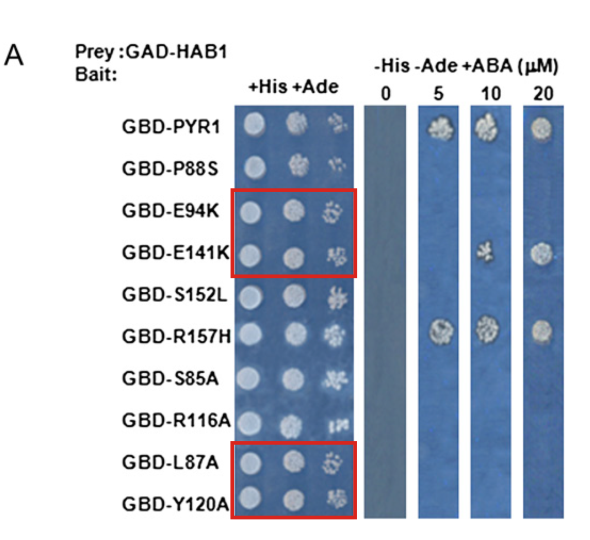
Santiago: “I did not perform the Y2H experiments used in this publication and I was not involved in the assembly of the figures. […] Although I have not done any of the flagged image manipulations, I regret that I did not spot these irregularities myself.“
There was of course more, that figure was even faker than first thought. Also Figure 4A was proven both fake and recycled between two PhD theses (Santiago’s and Antoni’s, but not Americo Rodrigues’), but rest assured Santiago will condemn the dead man with that one, too.

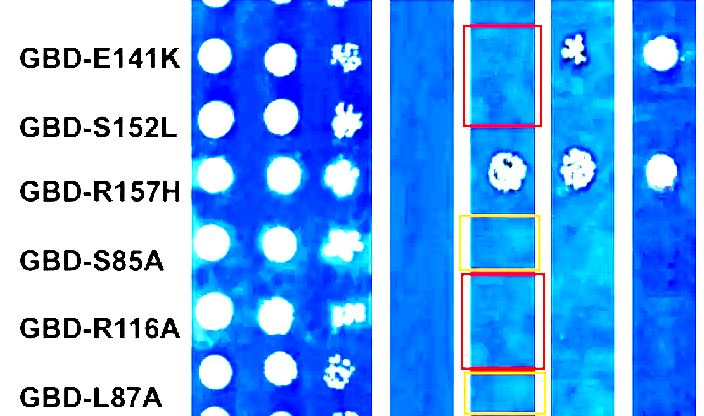
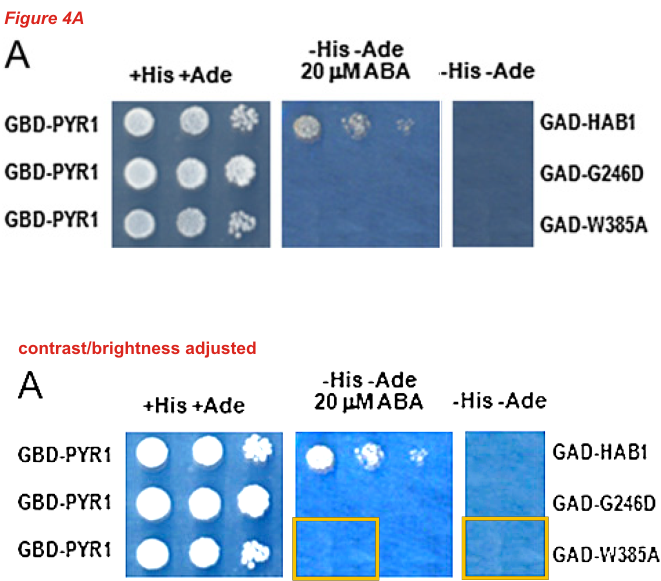
This figure is included in both Dr. Santiago’s thesis (page 113) and Dr. Antoni’s thesis (page 61).“
In this regard, the real problem with Dupeux et al Plant Phys 2011 paper is that it does not list Americo Rodrigues as co-author. If he faked those figures, why is he not on the paper? Why are these figures in Santiago’s and Antoni’s theses, but not in his? I do think this can be a very serious obstacle to Santiago’s cunning strategy, and I really want to help her to elegantly and creatively weasel out of it. So, whom shall we blame now?
The last author is Santiago’s other PhD supervisor, Jose Antonio Marquez at EMBL in Grenoble, France, but he can’t be blamed because the figure was reused by Antoni who did not work in Grenoble. Also the French might protest, hence better to solve this in Spain. Santiago’s insistence “I have not done any of the flagged image manipulations” leaves only one way out: blaming her former colleague Antoni. Especially since Antoni’s thesis contains this beauty (page 127 Fig 6.4):
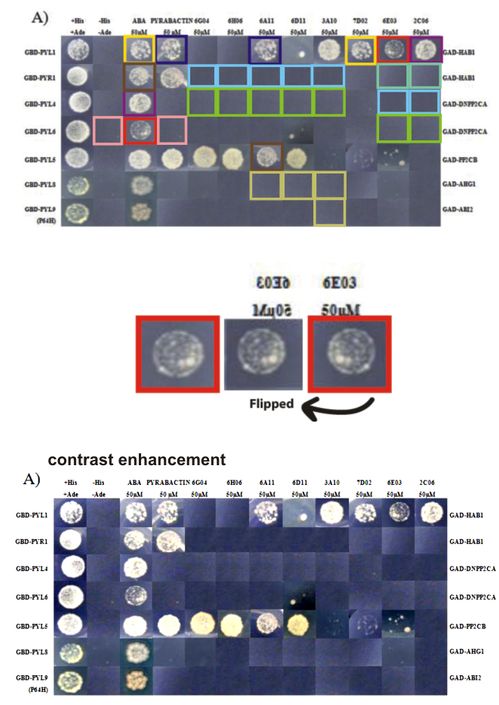

Problem is, unlike Rodrigues, Antoni is very much in the position to disagree with being the scapegoat for her former lab mate. Well, maybe it’s the best way out to be honest here? Just admit having done it, and say who taught you all to do science like this. You can always maintain that the conclusions of your papers in the top plant science journals are not affected by all the data manipulations.
It definitely looks that these insolent “adjustments” of results to fit a preconceived idea of a paper for a high-ranking journal is how Rodriguez trained his students. The man kept blaming on PubPeer the inanimate pin replicator and the dead PhD student, but the problem with cloned yeast colonies pops up in yet another dissertation from his lab.
Here the 2015 PhD thesis by Lesia Natacha Rodriguez Solovey (no relation to Pedro), supervised by Pedro L. Rodriguez Egea and his former PhD student Miguel Gonzalez Guzman (author of the problematic papers Gonzalez-Guzman et al 2012 and Gonzalez-Guzman et al 2004):
Identification of Targets and Auxiliary Proteins of PYR/PYL/RCAR ABA receptors: Protein Phosphatases Type 2C (PP2Cs) and C2-Domain ABA-related Proteins (CARs)
As it happens, the badly faked Figure 1A and 1B from Rodriguez, Gonzalez-Guzman et al Plant Cell 2014 are included as Figure 4.1 (page 76) in the PhD thesis:
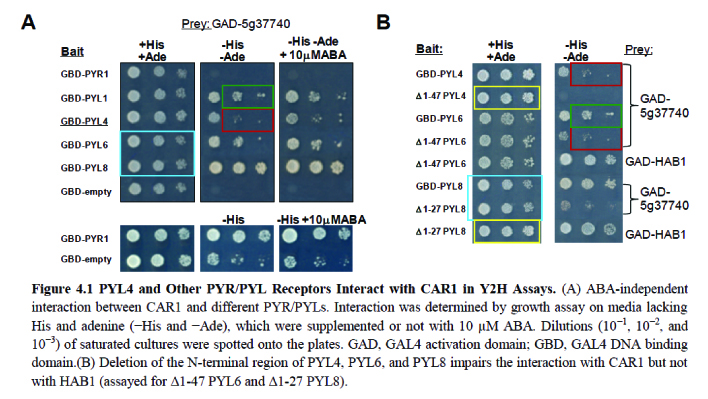
Rodriguez (the boss) previously commented on PubPeer under the name of Rodriguez (the student):

“Yeast two hybrid assays of this paper were done several years before, probably by the same person who was involved in Santiago et al., 2009.”
Yep, the “same person” aka the dead man Americo Rodrigues is co-author on the paper, yes, they will be blaming him for having faked Lesia Rodriguez’ PhD thesis also. Isn’t it the smoking gun proof against Americo that none of those figures is present in his own PhD thesis, only in the dissertations of others? Right? Right? Please slap yourself around till you agree.
This is Americo’s thesis by the way:
Not everyone became research group leaders of their own, like Santiago, Gonzalez-Guzman or indeed, the late Rodrigues. Maybe not everyone agreed to do science as the boss wanted them to. Not everyone was happy in that lab.
As I was informed, Silvia Rubio had serious conflicts with her boss which Rodriguez doesn’t want to talk about; she then studied medicine, left science and became a doctor. Rodriguez himself owes his professorship to the patronage of his PhD mentor Ramon Serrano, once the founder of the Department of Biotechnology at the Polytechnic University of Valencia, now emeritus professor at the same IBMCP in Valencia. Serrano is a powerful alpha male who used to demand total loyalty, the rewards were huge, punishments harsh.

Many other of the department’s current leaders are Serrano’s protegees, not just Rodriguez: Lynne Yenush, former Serrano postdoc, now Deputy Director of the IBMCP, Eduardo Bueso, former Serrano PhD student and now Deputy director of the Department of Biotechnology, Jose Miguel Mulet and Regina Niñoles, other former Serrano PhD students, now professors in the same department. I think in academia such relationships are called as “mafia”, in this case the Serrano mafia? In any case, these characters are now in charge of dealing with the case of their colleague Rodriguez, expect ruthless efficiency.
Now Santiago trains PhD students of her own, funded by the the Sandoz Family Foundation and the ERC. At least the University of Lausanne’s Vice-Rector for Research François Bussy informed me:
“I acknowledge reception of your messages. A follow-up will be given after the university Summer break.”
Also ERC wrote to me that they “have taken note of your email.” Let’s see if they handle that better than all the past cases, including the selection of their own president.
I exchanged many email messages with Pedro Rodriguez. Initially, he threatened to sue me. Then he became somewhat friendlier. But at no point did he seem overtly concerned that his lab may have published massive fraud and it may be his own fault. In his last communication, Rodriguez demanded to see my “journalism degree“:
“as you claim that you are journalist, could we have a look to the work you must have written to obtain your degree?
I mean, it is necessary a final degree project to get a title. I feel curious about“
Writing about research cheaters like you is my degree project, Pedro.
Carlos Lopez-Otin, another star of Spanish research caught on massive fraud, murdered all his mice (over 5000 of them) and escaped to Paris to stay with his friend Guido Kroemer. When Lopez-Otin returned to Spain, the former left-wing atheist became a national martyr saint and was seen preaching spiritual advice about “prepotency” of dinosaurs with the Opus Dei crucifix in the picture. Maybe Pedro Rodriguez will soon do something similar? I hope the Polytechnic’s greenhouse won’t catch fire.
Make a one-time donation
Make a monthly donation
Choose an amount
Or enter a custom amount
Your contribution is appreciated.
Your contribution is appreciated.
DonateDonate monthly

Hi Leonid – I appreciate your posts but this one is very hard to follow. Several people named Rodriguez appear but they are sometimes spelled Rodrigues making me think they were different individuals. And in the first paragraph, which person tragically died? You may consider that I am nit-picking but I found this post very confusing to read.
LikeLike
Americo Rodrigues is dead. His last name is spelled differently because he was Portuguese, not Spanish. Lesia Rodriguez is not related to Pedro Rodriguez, I asked.
It is supposed to be confusing and difficult to follow, all Almodovar films are.
But you are right, I misspelled the names at some places and will fix it now!
LikeLike
Thanks – the complex story is much clearer now!
LikeLike
Such a tangled plot:
1. Pedro Rodriguez has now 17 papers flagged in PubPeer for irregularaties
2. among these 17 papers, 11 contain severe image manipulations
3. among those 11 serious cases, the disastrous Santiago et al. 2009 is included, this article is about to be retracted by the authors
4. “who did what” in Santiago et al. 2009 is at the moment unclear, because in Dr. Santiago’s thesis the data are included in a “whole article” manner
5. Dr. Santiago claims she didn’t assemble figures of Santiago et al. 2009, although she is co-first author in first position
6. Dr. Santiago claims she didn’t select images for ANY figure of Santiago et al. 2009, although she is co-first author in first position
7. in Dr. Santiago’s thesis, however, there are many more manipulated data: Chaper 4 data (unpublished), and figures 3A and 4A from Dupeux et al 2011 Plant Physiol.
8. Dr. Santiago openly accused Dr. Americo Rodrigues in PubPeer for Chapter 4 data, data were included at the last moment as requested by her mentor Prof Pedro Rodriguez
9. PubPeer moderation removed that comment, later the comment was reposted without mentioning the name of deceased Americo Rodrigues as the culprit person
10. unfortunately Dr. Santiago forgot to credit (in her thesis) Dr. Americo Rodrigues for Chapter 4 data, data later turned out to be heavily manipulated
11. unfortunately Dr. Americo Rodrigues sadly passed away last year, and cannot be asked for these allegations
12. Dr. Santiago also denies ownership of figures 3A and 4A from Dupeux et al 2011 Plant Physiol., although again data are presented as hers in her own thesis, no credit to anyone else. But in this case Americo Rodrigues cannot be blamed, since he is not included in the paper
13. figures 3A and 4A of Dupeux et al 2011 Plant Physiol. are additionally included in Dr. Regina Antoni’s thesis. Dr. Antoni’s thesis was submitted two years later than Dr. Santiago’s thesis
14. in Dr. Americo Rodrigues’ thesis neither Chaper 4 data of Santiago’s thesis, nor figures 3A and 4A from Dupeux et al 2011 Plant Physiol. are present
15. in Dr. Americo Rodrigues’ thesis, instead, are present manipulated data published in Saez et al. 2008, and in no other thesis so far examined these data are included, although Dr. Angela Saez’ thesis wasn’t available so far
16. in Dr. Lesia Rodriguez’ (no family relation with Pedro Rodriguez) thesis are present manipulated data published in Rodriguez L. et al. 2014, and in no other thesis so far examined these data are included
LikeLike
Hi Aneurus,
Dr Angela Saez’s thesis is publicly available through this link. Introduction and Discussion sections are written in Spanish. Results section contain the four papers she published during her PhD. Some of them have been flagged in PubPeer so obviously the same flagged images are in her Thesis.
https://riunet.upv.es/bitstream/handle/10251/8658/tesisUPV3379.pdf?sequence=1&isAllowed=y
LikeLike
Thanks!
Unfortunately Saez’s thesis is less informative, as results are just a list of articles. Pity.
LikeLike
That is a great summary.
In regards to Dr Santiago blaming Dr Rodrigues for the manipulated images included in Dr Santiago’s Thesis. I think a key point here is that if Chapter 4 of Dr Santiago’s Thesis was a joint effort between Dr Santiago and Dr Rodrigues, why this work is not included (even not mentioned) in Dr Rodrigues’s PhD dissertation?
Another interesting question is who is responsible of the contents of your Thesis? To my understanding (and based on my own experience), it is the PhD student who writes and includes the Figures of his/her Thesis. Then the lab head provides feedback. I do not see a situation in which other people in the lab contribute to the PhD dissertation of someone else.
LikeLike
Leonidas Schneider, you are The King LIAR,
LikeLike
Well, I believe you are shooting the messenger here. You may like or not the way he is delivering this, but actually the liars here are those who took shortcuts and fabricated images.
LikeLike
What do you mean by “Rodrigues tragically died in 2020”? Covid, a car accident,,…? It’s terribly sad, he was too young to die.
LikeLike
More yeast problems at IBMCP Valencia, Alabadí group:
PubPeer thread is here:
https://pubpeer.com/publications/B4A62E9ADD938FD48E8416F13CE3BB#1
In this paper Salomé Prat is included.
Dr. Prat replied the following in another PubPeer thread on a paper of hers (a Nature paper, to be precise):
“It can be observed that in fact we duplicated by error this image. This mistake however affects a negative result and does not invalid the experiment and the interpretation of data. We regret this mistake but believe it is not strictly compulsory asking the Journal for publication of a correction note, including the ammended Figure.”
PubPeer thread is here:
https://pubpeer.com/publications/D7CD2167EC004273AB1AB82FC5C5B4#4
LikeLike
At least Dr. Salomé Prat promised to correct this one, over a year ago:
https://pubpeer.com/publications/19A8A554217EB6E3ACC73EBA28A34F#4 (yeast again)
but nothing happened as of today. Maybe she changed her mind, it is not strictly compulsory to do anything after all.
Dr. Prat has this one too, yeast again, a kind of a national plague in Spain:
https://pubpeer.com/publications/1CED6DE06223FDB15B296F56D25582#1
LikeLike
any update from ERC or the University of Lausanne?
LikeLike
There must be an investigation also by the Polythecnic University of Valencia (UPV), as far as I know.
LikeLike
The retraction of Santiago et al. 2009 Plant Journal did not occur yet, six months after it was announced. EiC of the journal, Dr. Lee Sweetlove, when asked for an update, did not reply. This whole thing is shrouded in mistery.
LikeLike
Julia Santiago proudly advertises her latest paper and first as group leader:
Reactions on twitter are of course a burst of applauses.
Coincidently, today I got an update from Wiley on the status of Santiago_et_al_2009:
My email to EiC:
“Dear Prof. Sweetlove, I hope this email finds you well.
May I kindly ask you to provide an update on this article (–> Santiago et al. 2009) please?
The corresponding author apparently asked for retraction of the paper, but the paper is not yet retracted. Meanwhile, this disastrous article has been cited ten more times since June last year.
Could you please explain me why it takes that long? Kind regards.”
Rosie Trice (Wiley):
“Dear …, thank you for your email that was forwarded to me. Apologies for the time taken to conclude our investigation into this paper. We are actively liaising with the authors and hope to conclude this very soon. Several of the authors are out of contact which can hinder progress. Thank you for your patience.”
As Leonid pointed out, hopefully Wiley has been informed that sadly Dr. Americo Rodrigues is deceased, otherwise the “progress” could be unduly delayed.
LikeLike
Pingback: Iberian yeast masters do it classic with a flip – For Better Science
Pingback: Rick Vierstra probably meant well – For Better Science